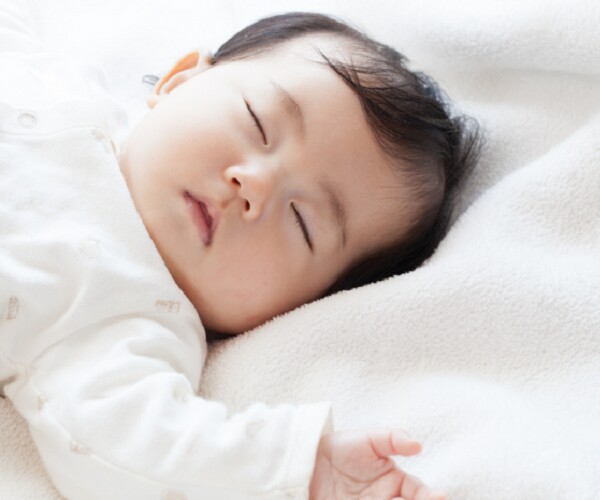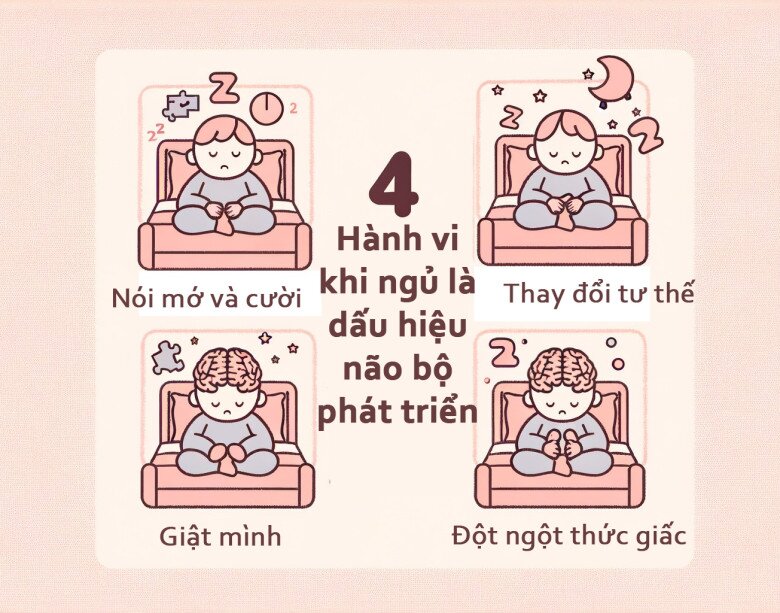Some “unusual” behaviors in children during sleep can actually be signs of a healthy developing brain.


Sleep Talking and Laughing
Some children mumble in their sleep, sometimes even laughing or crying. This is a sign that their brains are very active during deep sleep.
Research has shown that children’s brain activity during sleep can be greater than that of adults. They organize what they have learned during the day, simulating various emotions and scenarios while asleep.

These “sleep conversations” and facial expressions like smiling or frowning are signs that the brain is processing and rehearsing emotions.
When children mumble, they may be trying to resolve new experiences or even small worries in their daily lives. This indicates that their brains are actively working to understand and integrate what has happened.
Moreover, during the REM (Rapid Eye Movement) phase, the children’s brains function similarly to when they are awake. During this phase, they relive their experiences and also imagine new situations.
This shows that their neural networks are developing rapidly, laying the foundation for future emotional management and social skills.

Sleep Talking and Laughing.

Tossing and Turning, Changing Sleep Positions
If a child changes sleep positions throughout the night, from lying on their back to their stomach, or even curling up into a small ball, they may be seeking the most comfortable and secure position. These changes are not just habits but also reflect the child’s needs.
Tossing and turning helps relieve muscle tension, promote blood circulation, and support healthy development. When children change positions, their muscles relax and regenerate energy, while also improving recovery after a day of activity. This is crucial during the growth phase when the body and musculoskeletal system are still developing.

Tossing and Turning, Changing Sleep Positions.
More importantly, this is a sign that their brains and nervous systems are active, indicating improved coordination between their bodies and brains.
When children sleep, their brains don’t rest but continue to process information and consolidate learned skills. Changing positions can be the body’s natural response to finding an optimal balance and is also a testament to the development of cognitive and reflex abilities.

Occasional Startle Reflex or Sudden Movements
Many parents are surprised to see their children suddenly jerking their hands and feet during sleep. This phenomenon, called the “startle reflex,” is common in infants and young children. It is a natural response, reflecting the development of their nervous system and their ability to control their limbs.
The startle reflex usually occurs when children are transitioning between sleep stages, especially from deep sleep to light sleep. During this process, the brain is active in adjusting signals and controlling the body. Thus, the brain is learning and developing, experimenting with its ability to control its limbs.

Occasional Startle Reflex or Sudden Movements.
When children startle, it may be the brain’s way of processing external stimuli or dreams they are experiencing.
As long as this reflex doesn’t occur frequently enough to disrupt their sleep or daily activities, there’s no cause for concern. However, if it happens continuously and causes discomfort, parents should consult a doctor to ensure there are no underlying issues.

Briefly Waking Up or Sitting Up at Night
Some children may briefly wake up at night, even sitting up and looking around before lying down to sleep again. This is especially common during the transition between deep and light sleep.
This is not only part of the sleep cycle but also indicates that the brain is learning to self-regulate sleep and naturally transition during the night, which is crucial for establishing healthy sleep habits.

Briefly Waking Up or Sitting Up at Night.
Therefore, parents should pay attention to these sleep behaviors but not worry too much. These “unusual” behaviors are considered signs of healthy brain development in children.
Additionally, creating a quiet and comfortable sleeping environment is essential for children’s growth and development. Quality sleep is the key to ensuring brain development. So, these little movements during sleep are the secret signs of a smart brain at work.







































